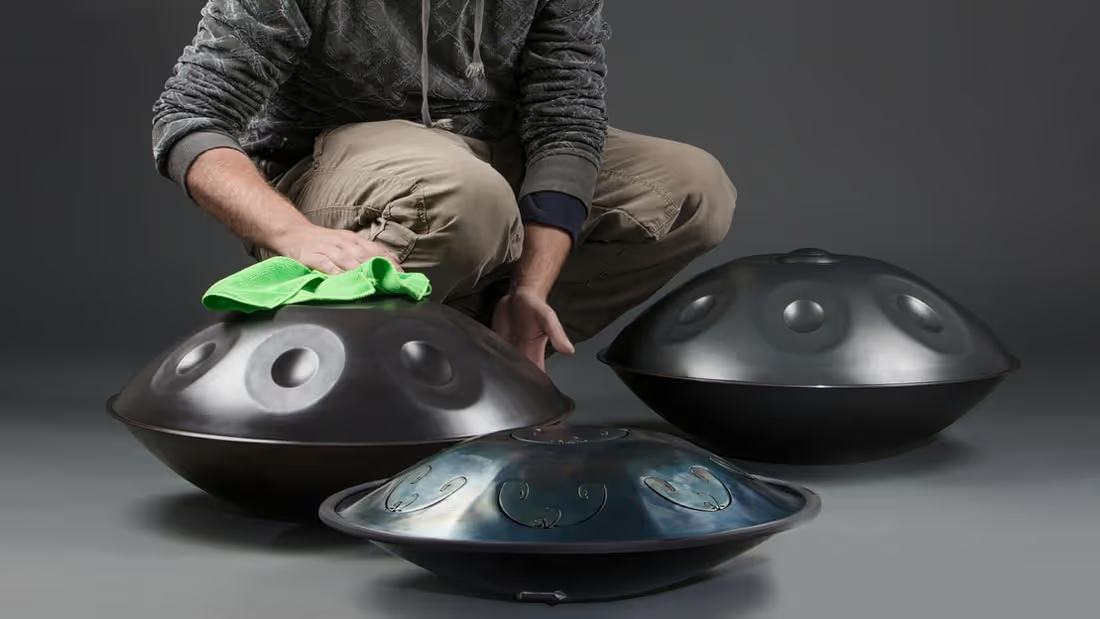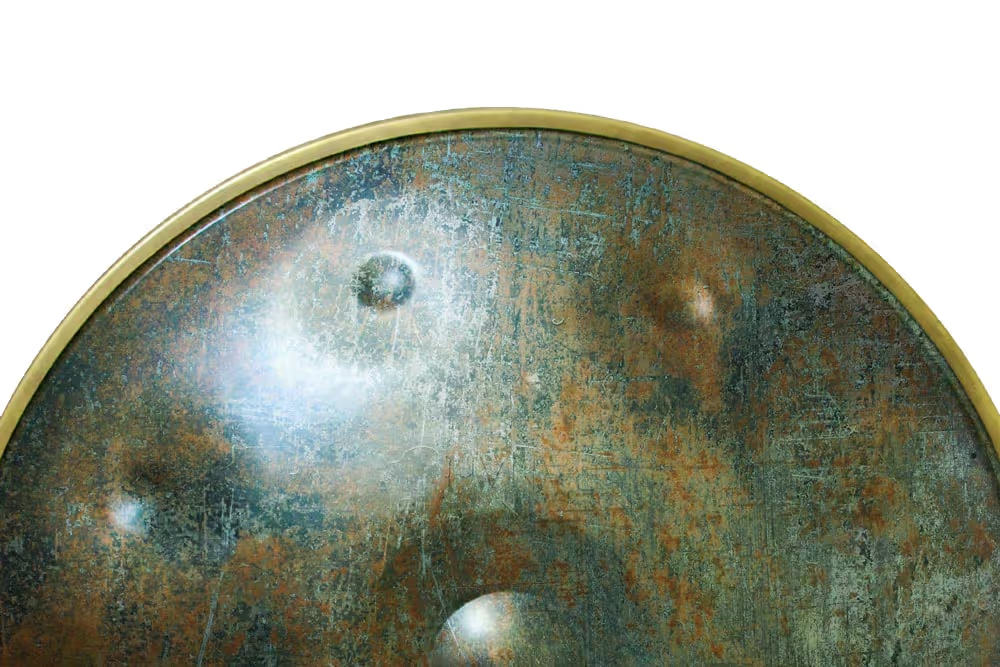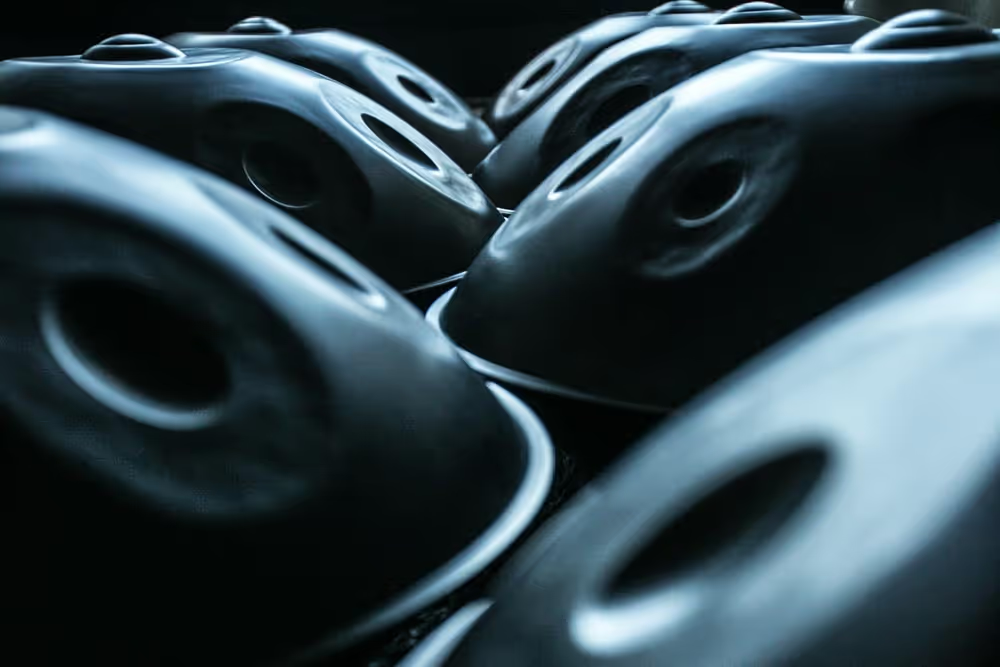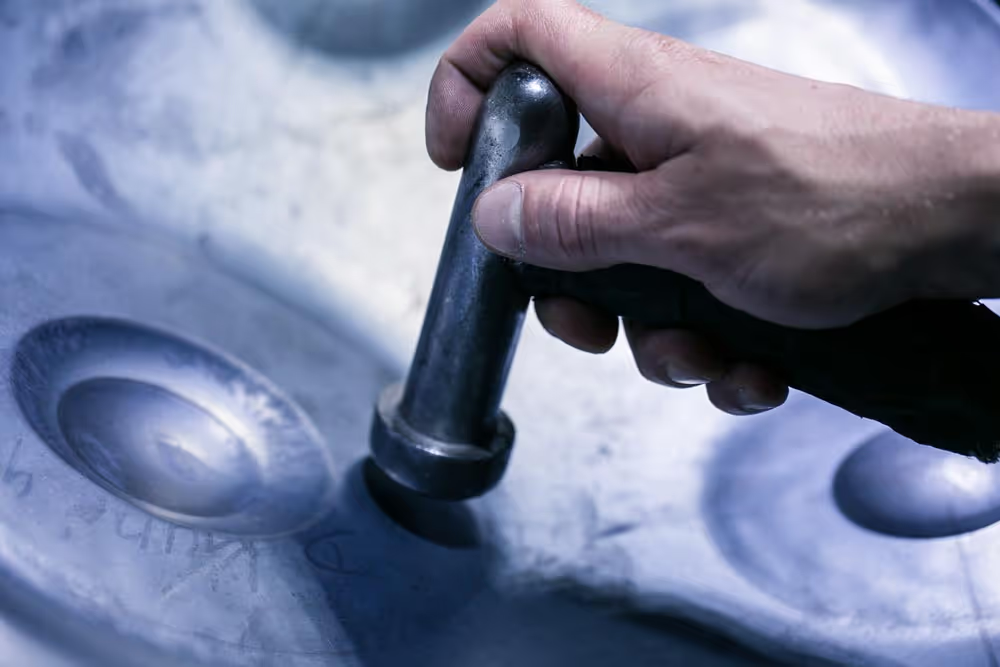The RAV Vast is a unique tongue drum with unrivalled harmonics and oh-so-sweet sustain. This is why so many of us handpan players (including me) have added it to our collection. Due to your RAV-enous requests for more info, here’s my breakdown on the history, characteristics and magic of the RAV Vast.
The history of the RAV Vast
The RAV Vast began with one man’s dream: Andrey Remyannikov, a Russian engineer. As a student, Andrey was captivated by the Hang (read more about handpans) but couldn’t afford such a piece of art, so he set about trying to build his own version with a sound that could rival it.
He used his engineering skills, technology and understanding of the physics of the sound to produce his instrument.
In 2013 - after 18 months of daily work, several broken metal barrels and 100 rejected forms of ‘tongue’ (note) - Andrey’s first prototype was born. 100% hand-crafted, it was a homage to the Hang, but with a different look and totally unique sound.

He adopted the name RAV after handpan forum members and the drums’ very first owners took his full name - Remyannikov Andrey Vladimirovich - and gave the instrument this nickname.
Andrey realised that his invention could be offered to other people just like him so he set about improving the ‘RAV Drum’ prototype.
After another year of development in a garage, including experimenting with larger shells and tongues, he finally launched the version we know today, replacing the word ‘Drum’ with ‘Vast’ in reference to its deep, long and overwhelming sustain.
Unlike handpans, tongue/tank drums and other hand drums which are empty inside, the RAV Vast has metal ribs that help to make its sound distinct and clear.
My first RAV Vast experience
I heard about the RAV on forums when it was still a fledgling prototype. Then in 2015, at the French handpan festival, I had my first opportunity to see it and play it.
The look of the RAV was so fresh - the same basic shape as my beloved handpans, but everything pressed smooth and flush. As a child obsessed with percussion, I was constantly told off for doing finger rolls on every available flat surface. 😉
So imagine my joy at seeing an instrument that was as easy to play as a kitchen table! It was beautiful to touch, in fact it practically begged to be touched with its unique look and finish. It felt more ‘futuristic’ than anything I’d experienced before.
But more than that, upon speaking to the maker, I truly appreciated the in-depth research and craft behind it. Andrey is such a great guy - truly passionate and knowledgeable. We’ve been friends ever since.
Having been used to the handpan’s voice for so many years, my ears fell in love with the RAV Vast’s whole new sound. Deep, rich, warm and resonant, I was enchanted. The range of harmonics on each tongue - somewhere between 4-7 tuned partials - made it particularly exciting to explore and play. There was great responsiveness and rebound with my fingers.
Even in its early days, it was easy to get a clear sound from each tongue with minimal energy, making it perfect for beginners and youngsters as well as pros. (It can also be played with special mallets so it’s good for those with manual dexterity issues.)
Oh, and that sustaaaaaaaaain! The RAV is not just named Vast because of sustain, it’s famous for it. Andrey spent a lot of time calculating ratios, constructing the inner ribs, intricately shaping and tuning the tongues and using precise musical engineering in order to achieve this sound quality... and it shows.
With each tongue emitting up to 7 clean and balanced overtones along with the main note, the RAV is basically its own choir.
There and then at the festival, I asked Andrey if I could have one. He offered me two - a G pygmy and a B Celtic. 5 years on, I’m still in love with them. With their magnificent sustain and gong-like, bassy sounds, they are a great addition to my percussion arsenal.
Aside from the fast trills and rolls, overall they push me to play slower, more reflectively and meditatively. Playing on my lap, my whole body vibrates. As such, they feel both interactive and calming. While different in many ways to the handpan - tonally, in the number of partials, in material, look, feel and playing style (as well as price) - they go so well together. I use them regularly in my compositions as a root to ground my chords.
What it takes to build a RAV Vast
Andrey founded RAV Labs in the city of Perm, Russia, an impressive workshop that aims to match production with demand and also to develop new additions to the RAV Vast and RAV Pan ranges. The company also has a warehouse in Estonia to help facilitate delivery worldwide.

While most handpan makers are small, often just one individual, in comparison, the RAV team is huge. Aside from a sales and delivery team of 12 staff, they now have about 80 people who work in production, grinding, welding, glueing, painting, putting on rims, tuning, checking and packing your future instruments. They are all dedicated to making each instrument a little piece of art.

The RAV’s unique tongues - completely different from a standard tongue or tank drum - make the instruments unique and instantly recognizable. In fact RAVs are so unique that they have been successfully patented. The tongues are even incorporated into the company logo.

As for production of these 20”/51cm, 9 note singing beasts, it takes 13 people and about 7 days to make one RAV, with 80% of the production still being hand-crafted according to a strict 6-step quality control process that ensures both their uniqueness and reliability.
Since their popularity really took off in 2015-6, the RAV family has grown. In addition to the RAV Vast (1.5mm), there’s the RAV Vast2 (2mm) and the new, 2020 limited editions RAV Vast Golden and RAV Vast2 Golden (with gold finishes).
With an impressive 18 scale variations between them and new sound models in development, RAV lovers are spoilt for choice.
Should you buy a handpan or a RAV Vast?
This isn’t a case of either/or... if you are a musician, I believe it’s better to have both! They are very different and both have their plus-points. If your current funds allow for only one, then it’s a matter of personal taste.
Listen to as many videos as possible, play both if you can and ultimately go with your heart, fingers and ears.
- If you want to buy a handpan, here's a complete guide to make the best decision for your future purchase
- For yoga, meditation and sound healing, for a tough instrument that can be played in the sun and requires little-to-no re-tuning, and for those on a tighter budget, RAVs are probably more suitable as well as cheaper.
What is the cost of a RAV Vast?
Andrey and his team work very hard to optimize their production expenses and processes, thus keeping net costs much lower than the average handpan (read more on how much does a handpan cost). For example, RAVs are a bit easier to tune than handpans.
Direct from RAV Vast themselves, all but one of their 2020 prices vary between €730-831 (with the RAV Vast Low E Pygmy at €930 due to its more intensive build and tuning process).
This currently includes various free and discounted shipping deals (to the EU).
How to order a RAV Vast
The best way, to avoid scams and to ensure quality after-sales service, is to order them from the official RAV Vast website (see below) or any official RAV reseller.
Use your common sense - if someone is offering an 80% discount on the price, it’s likely to be a con. If you find one you like that is not directly on sale from Andrey and team, we encourage you to read comments on that seller, check their social media, ask handpan community members, other RAV owners etc. (read more on how to avoid getting scammed).
You can also contact the RAV team and check with them if a reseller is reputable.
🔥 You can get 7% off your purchase thanks to a partnership with have with the team (this is an affiliate link). Select your region below:
- Europe: eu.ravvast.com
- Rest of the world: ravvast.com
The difference between RAV Vast and RAV Vast2
The RAV Vast is made from two different thicknesses of steel: the RAV Vast in 1.5mm and the RAV Vast2 in 2mm. This is because some tunings simply work better in thicker steel and some in thinner steel.
For example, all the B tunings have been made from 2mm. Vast2 is purely the marking for models made from 2mm steel. It is not an improved model of the instrument or ‘next generation’.
It is not technically possible to make certain Vast scales in 2mm steel and vice versa, so, for example, you cannot get a RAV Vast2 G Pygmy or a RAV Vast B Celtic Minor. There's no difference in price or sound quality between Vast and Vast2.
How to choose a RAV scale
Today there are 18 different RAV Vast scales (as well as the limited edition Golden models and 4 RAV Pans) and the team is constantly working on new ones. Each scale represents a certain mood, inspired by a particular culture or harmony.
While players preferences change from month-to-month, B Celtic Minor, D Major and G Pygmy are really popular. They are recommended if you are a beginner.
On a side note, the RAV team’s favourite is Low E Pygmy because it has really powerful vibe.
It doesn’t matter if this is your first RAV Vast or if you already have a family of them, plus handpans and other instruments, because of the range of choice, you will find a tuning to your taste and needs. Just keep watching videos and playing them live if you can. Read more on how to choose the scale of your RAV.
Here’s a handy scales overview:
How to play the RAV
Technically, although many skills are transferable, the RAV is different from the handpan. To bring out the vast (excuse the pun) amount of sounds that it can produce, just explore it and have fun with it. It’s a tough little beast so don’t be afraid to use your fingers, knuckles, nails, palms and RAV mallets, stroke it, hit it, waft it and gently flick up the tongues with your nails.
After receiving many Master The Handpan student requests, I created a whole new set of tutorials designed specifically to tackle the RAV and learn how to really make it sing.
By the way, not only this course is recommended by the RAV Team, it's actually the official course for RAV Vast beginners players. 👍
How to take care of a RAV
New RAVs are protected with anti-rust coating and thus require very little maintenance. Get into the habit of wiping down your handpan with a soft, clean, dry cloth, preferably microfibre. The maker recommends that you oil them lightly once a week.
Older models need more thorough care, oiling about 2-3 times a week if you live in a moderately humid area. We recommend Phoenix Oil or Frog Lube for this.
RAV pro Ricky Hillson has a useful cleaning guide here:
Additionally, they require little-to-no re-tuning. The way the RAV is engineered and the material and treatment that form them, if you just play them with your hands (versus mallets), they should never go out of tune.
They don’t lose their tuning if you leave them in the sun/somewhere hot either which is not the case for handpans. Overall, they are very sturdy and tough, making for less nerve-wracking travel (read more on how to fly with your instrument).
Of course, you should still take care of them - they cannot be used as frisbees or trampolines! 😉
And finally, a fun fact I learnt from Andrey
It’s rather ironic, but RAVs are not very well-known in the place where they were invented and are made. When Russians see the instrument, they usually ask ‘Is it a Hang or a tank drum?’ In truth, it’s a bit of both and then something altogether different.
I am so grateful to Andrey and the team at ravvast.com for creating the RAV, for introducing me to them and for sharing their time and information in helping me to write this guide.
My first love may have been the handpan, but there’s a big place in my heart (and in my recording studio) for the RAV Vast. I hope that all my readers and students get the chance to discover its magic for themselves.
Interested in buying a RAV Vast?
Thanks to a partnership with have with the team you can buy a RAV directly from MasterTheHandpan Marketplace
Click here to shop for a RAV Vast on MasterTheHandpan Marketplace
Enjoy!














